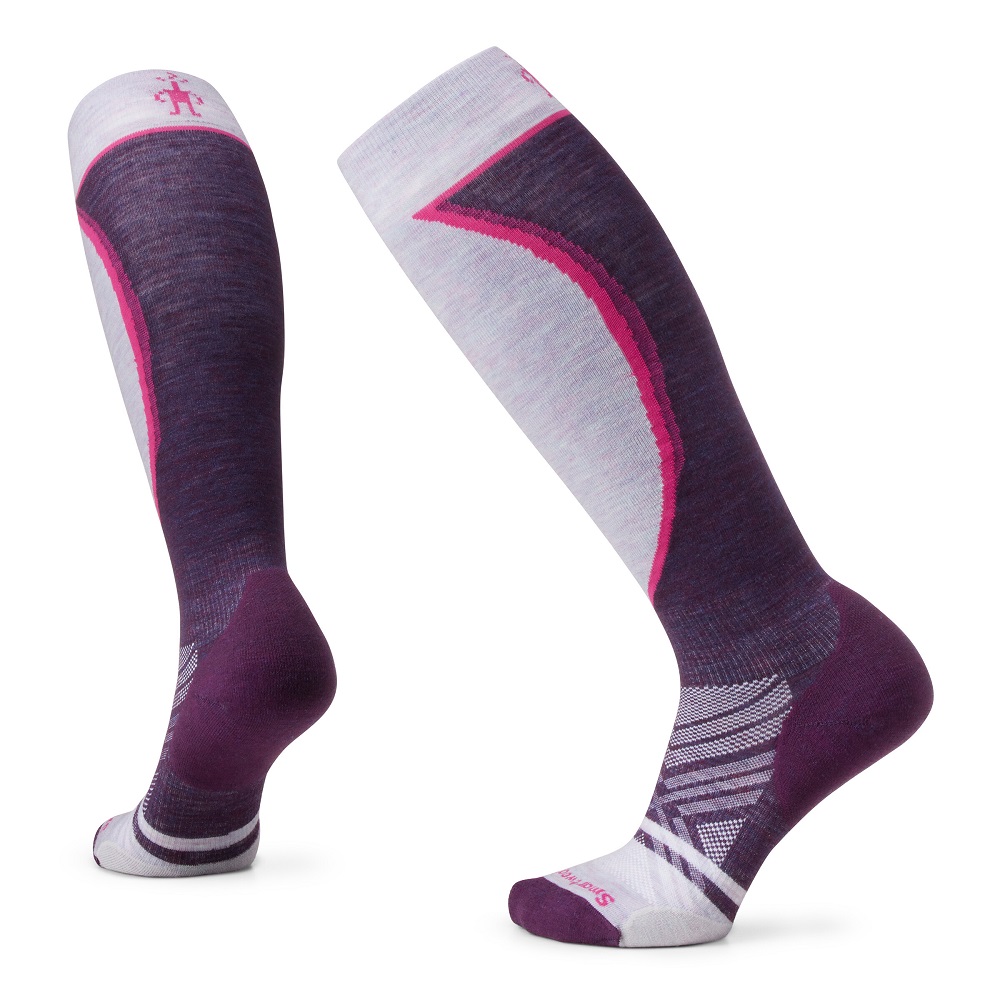Importance of Ski Socks in Winter Sports
Ski socks are more than just an accessory for winter sports. They play a crucial role in ensuring comfort, safety, and performance during your time on the slopes. Choosing the right ski socks can greatly enhance your overall skiing experience while protecting your feet from common issues.
Enhancing Performance and Safety on the Slopes
High-quality ski socks help improve your performance by providing better grip and support. Properly designed socks prevent unnecessary foot movement in your ski boots, reducing the risk of instability. They also keep your feet warm, allowing you to stay focused on skiing instead of feeling cold. Good ski socks enhance blood flow and help your muscles recover faster. This improves endurance and makes skiing safer and more enjoyable.
Preventing Blisters and Foot Fatigue
Blisters and foot fatigue are common problems during long skiing sessions. Ski socks with proper padding reduce friction and protect your feet from blisters. Additionally, well-cushioned socks provide support to reduce foot strain and fatigue. Moisture-wicking materials keep your feet dry, further minimizing the risk of irritation. Ultimately, ski socks designed for comfort help you ski longer without pain or discomfort.
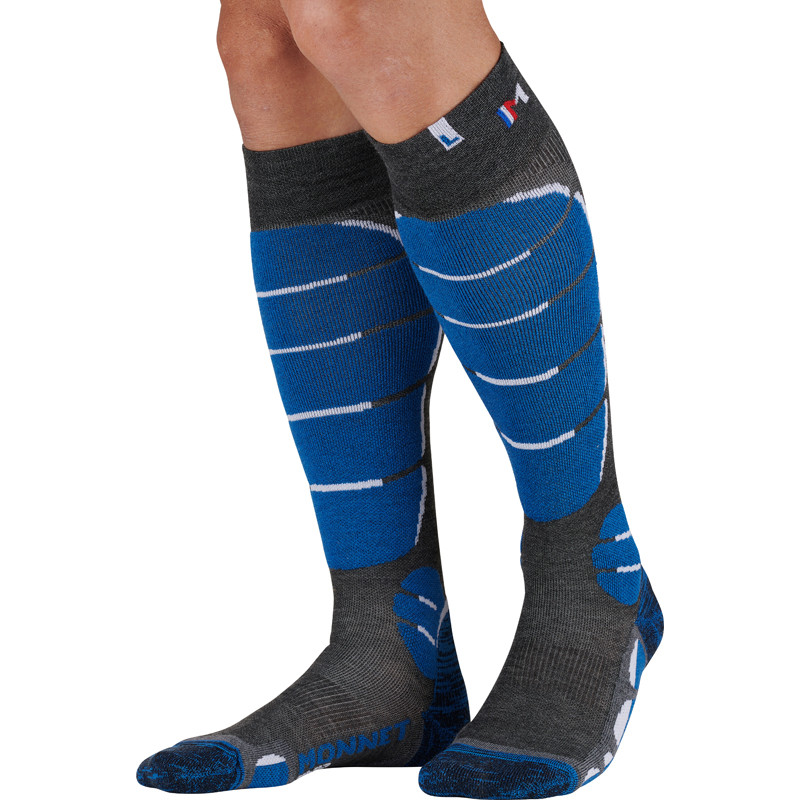
Materials Used in Ski Socks
Choosing the right materials for ski socks is essential for comfort and performance. Each material offers unique benefits, ensuring your feet stay warm, dry, and supported during winter sports.
Merino Wool vs Synthetic Materials
Merino wool is a natural fiber known for its softness and warmth. It regulates temperature well, keeping your feet warm in cold conditions and cool when it’s warmer. Merino wool is also odor-resistant, reducing unpleasant smells after long days of skiing.
Synthetic materials, like polyester and nylon, are designed for durability and quick drying. These materials are lightweight and often blended with elastic fibers for a better fit. Synthetic ski socks are also less expensive and resistant to wear and tear.
Both materials have their strengths. Merino wool prioritizes comfort and warmth, while synthetics offer durability and affordability. Many ski socks combine these materials for a balanced experience.
Moisture-Wicking Properties and Breathability
Moisture control is crucial when choosing ski socks. Socks with moisture-wicking properties keep your feet dry by moving sweat away. This feature prevents unpleasant odors and reduces the risk of blisters.
Breathable materials further enhance comfort, allowing heat and moisture to escape. This prevents your feet from feeling too hot or sweaty in your ski boots.
Look for socks labeled as moisture-wicking and breathable, combining these features for an optimal skiing experience. Merino wool and advanced synthetic fibers often excel in these areas, ensuring you stay comfortable all day.
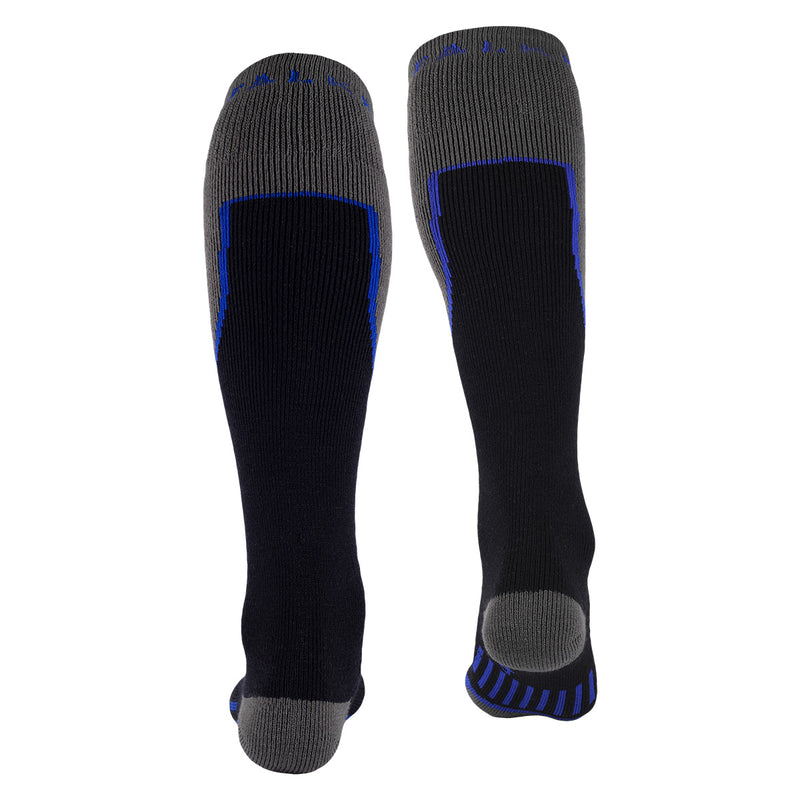
Features to Look for in Ski Socks
Choosing the right features in ski socks can make your time on the slopes more comfortable. Specific attributes like padding, length, fit, and compression are vital for both performance and protection. Below, let’s explore these key features in detail.
Padding for Extra Comfort and Support
Padding in ski socks adds extra comfort and support for your feet. It cushions pressure points, reducing strain from tight ski boots. Look for socks with targeted padding in areas like the heel, toes, and shin. These zones often experience the most friction. Well-padded socks minimize foot pain, allowing you to ski longer without discomfort. Padding also protects against impacts, making it ideal for demanding terrains.
Length and Fit for Optimal Coverage
The length and fit of ski socks are crucial for adequate coverage and protection. Over-the-calf lengths offer maximum coverage, safeguarding your lower leg from boot chafing and cold exposure. A snug fit ensures the sock stays in place during active movements, preventing bunching or slipping. Properly fitting socks enhance circulation and prevent discomfort while skiing. Always check the sizing guide to find the perfect fit for your feet.
Compression for Improved Blood Circulation
Compression socks are designed to boost blood flow and reduce muscle fatigue. This feature helps maintain warmth and prevent swelling during long ski sessions. Gradual compression ensures optimal circulation from the foot to the calf. Compression also aids recovery after skiing, reducing soreness in your muscles. Many advanced ski socks include compression zones for superior performance and comfort.
In conclusion, prioritize ski socks with the right padding, length, fit, and compression. These features will elevate your skiing experience while protecting your feet effectively.

Comparing Different Ski Sock Brands
Choosing the right ski sock brand can enhance both your comfort and performance. Different brands offer unique features to suit various needs and budgets. Let’s explore these options to help you make an informed decision.
Popular Brands and Their Unique Features
Several brands stand out for their quality and innovation in ski socks. Here are some popular options:
- Smartwool: Known for their premium merino wool socks, Smartwool excels in warmth and moisture-wicking. Their socks are soft, breathable, and durable, making them a top choice for dedicated skiers.
- Darn Tough: Famous for their lifetime guarantee, Darn Tough ski socks are highly durable and resistant to wear. They offer excellent cushioning and support, perfect for long skiing sessions.
- Stance: Combining function with style, Stance produces socks with unique designs and solid performance. Their ski socks feature targeted padding and arch support for comfort and stability.
- CEP: A leader in compression ski socks, CEP provides superior blood flow and muscle recovery. These socks are ideal for skiers seeking improved circulation and reduced fatigue.
Budget-Friendly vs Premium Options
When choosing ski socks, understanding the difference between budget-friendly and premium options can help:
- Budget-Friendly Socks: These are often made of synthetic materials like polyester. They are affordable, lightweight, and quick-drying but may lack advanced features such as targeted compression or extended durability. Brands like Wigwam and Fox River offer good budget options.
- Premium Socks: These are crafted using high-quality materials like merino wool or advanced synthetic blends. They include features like padding, moisture-wicking, and compression zones. Premium socks, such as those from Smartwool or Darn Tough, provide superior comfort, longevity, and performance. They come at a higher price.
Ultimately, the choice between budget-friendly and premium ski socks depends on your priorities. Casual skiers may opt for budget socks, while frequent skiers benefit from investing in premium options.
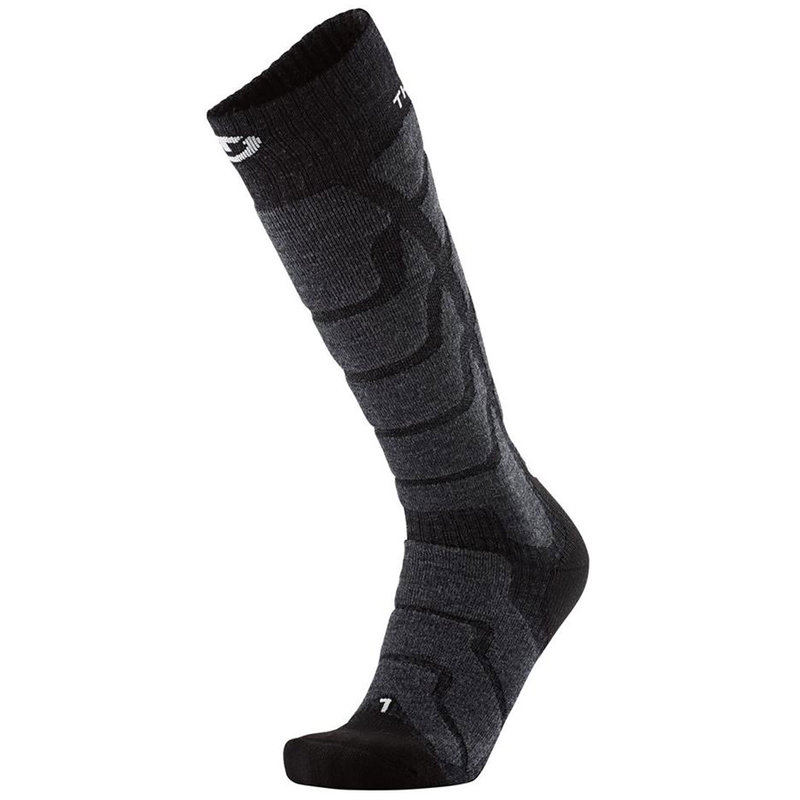
Caring for Your Ski Sock
Proper care for your ski socks ensures they remain comfortable and durable over time. Taking the right steps in washing and storing them can prolong their life and maintain their performance features.
Washing and Drying Tips
- Use Cold or Warm Water: Always wash ski socks in cold or warm water. Hot water can shrink the fabric or damage elasticity.
- Gentle Cycle is Key: Wash your socks on a gentle cycle to minimize wear and tear.
- Avoid Harsh Detergents: Use mild detergents without bleach. Harsh chemicals can weaken the material.
- Turn Socks Inside Out: This helps protect the outer surface and effectively removes sweat from inside.
- Air Dry Whenever Possible: Avoid using a dryer. Air drying preserves the sock’s shape and elasticity.
- Avoid Fabric Softeners: Fabric softeners can reduce moisture-wicking performance and make socks less effective.
Following these simple washing and drying tips will help your ski socks perform better and last longer.
Maintaining Durability for Long-Term Use
- Store Socks Properly: Keep socks in a clean, dry place. Avoid stuffing or wrinkling them.
- Rotate Your Pairs: If you ski often, rotate between multiple pairs. This prevents overuse of a single pair.
- Watch for Wear and Tear: Check for thinning fabric or holes. Replace worn socks promptly to ensure comfort.
- Avoid Outdoor Use: Don’t use your ski socks for daily wear. This can cause unnecessary wear and degrade them faster.
- Keep Nails Trimmed: Long nails can snag the fabric, causing holes or tears. Keep toenails well-trimmed.
By taking these steps, you can maintain your ski socks’ quality and extend their lifespan. Proper care ensures comfort and performance every time you hit the slopes.
Common Mistakes When Choosing Ski Sock
Selecting the right ski socks is vital for comfort and performance. Avoid these common mistakes to ensure an enjoyable skiing experience.
Overlooking Size and Fit
One common mistake is choosing incorrect sock sizes. Ill-fitting socks can ruin your skiing day. Socks that are too tight restrict blood flow, causing cold feet. On the other hand, loose socks can bunch up and cause blisters. Always check the sizing chart before purchasing. Make sure the socks fit snugly without being restrictive. A proper fit prevents pressure points and ensures maximum comfort.
Prioritizing Style Over Functionality
Style should not overshadow functionality in ski socks. Many skiers choose socks based on colors or patterns alone. While appealing designs are fun, they should not compromise performance features. Functional socks provide essential benefits like warmth, moisture-wicking, and padding. Prioritize materials, breathability, and compression when selecting socks. Choose socks that look good but also support your skiing needs effectively.
Avoid these mistakes, and you’ll enjoy more comfortable and safer skiing sessions.
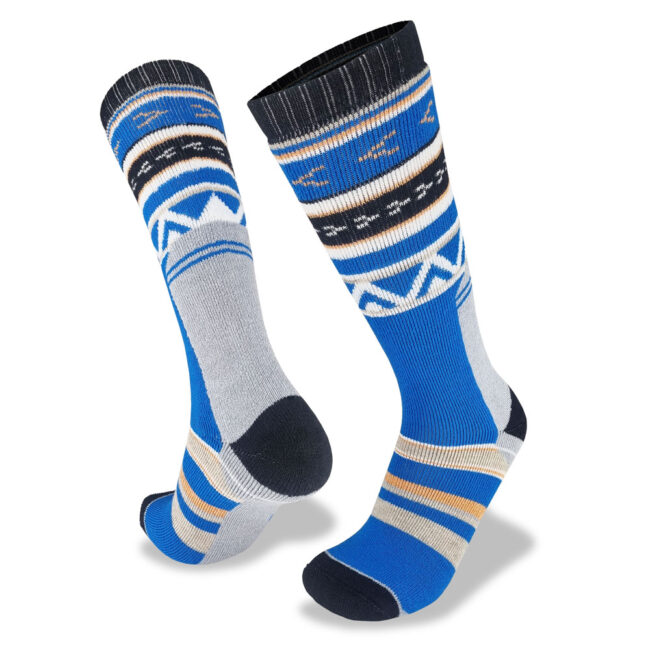
Where to Buy Quality Ski Sock
Finding quality ski socks is essential for comfort and performance on the slopes. Whether you prefer online shopping or visiting physical stores, it’s important to choose reliable sources for your gear.
Online Stores vs Physical Retail Shops
Online Stores:
- Offer a wide range of options from global brands.
- Provide detailed product descriptions and customer reviews.
- Allow convenient price comparisons and doorstep delivery.
- Popular platforms include Amazon, Backcountry, and REI.
Physical Retail Shops:
- Allow you to try the socks for the right fit.
- Have knowledgeable staff to guide your purchase.
- Offer the chance to inspect materials and features firsthand.
- Ideal options include local sporting goods stores or ski gear outlets.
Both methods have their advantages. Online shopping provides variety and convenience, while physical stores offer hands-on experience.
Seasonal Discounts and Deals on Ski Gear
Seasonal sales are an excellent way to buy high-quality ski socks affordably. Here are the best times to find deals:
- End-of-Season Sales: Many retailers offer discounts as the ski season ends. These sales help clear inventory.
- Holiday Promotions: Look for deals during holidays like Black Friday and New Year.
- Pre-Season Sales: Early autumn is perfect for discounted gear before the skiing season starts.
- Membership Benefits: Joining loyalty programs from brands can unlock exclusive discounts and rewards.
Planning your purchase during sales ensures great quality at lower prices. Keep an eye on promotions and plan accordingly.
Knowing Your Skiing Conditions
The skiing conditions you anticipate will heavily influence your sock selection. If you are skiing in extremely cold weather, insulated socks with thicker padding will help in retaining heat. Conversely, if you are heading to a warmer climate or skiing during the spring months, thinner socks might be a better fit. Additionally, the type of skiing you engage in—whether downhill, cross-country, or backcountry—can determine which socks will work best.
Adjusting for Terrain and Weather
For example, backcountry skiers may need socks that provide more cushioning for hikes and descents, while downhill skiers may benefit from socks that prioritize a snug fit. Take into account the type of terrain, expected temperatures, and duration of your ski sessions when choosing socks. Understanding these factors will enable you to select the best socks for your specific skiing scenarios. By selecting the appropriate socks for your skiing conditions, you can ensure your feet remain comfortable and well-supported, allowing you to tackle varying terrain confidently.
Invest in Comfort for Optimal Performance
In conclusion, selecting the right ski socks is crucial for every skier. By taking into account materials, thickness, fit, and specific needs, you can find socks that enhance your skiing experiences. Remember that the right socks can make a significant difference in terms of comfort, warmth, and performance on the slopes. Investing in high-quality ski socks not only keeps your feet warm and dry but also helps prevent blisters and discomfort, allowing you to focus on enjoying your time skiing.
Elevate Your Skiing Experience
As you prepare for your next ski trip, prioritize finding the right ski socks. Take the time to assess your needs, try on different options, and choose a pair that feels comfortable and supportive. With the right ski socks, you can elevate your skiing experience, ensuring every run is enjoyable and free from discomfort. Happy skiing! With the perfect pair of socks, you’re ready to conquer any slope and enjoy every moment on the mountain. Don’t forget that well-prepared feet make for successful outdoor adventures. Be smart and prioritize what goes on your feet; it’s an investment that pays dividends on the slopes.
